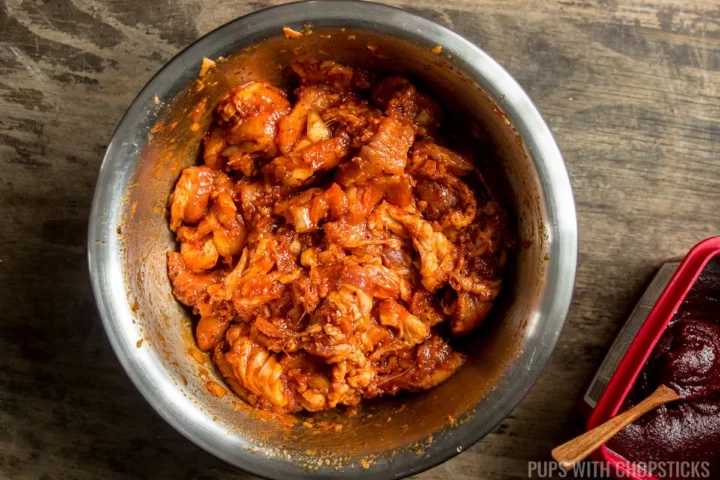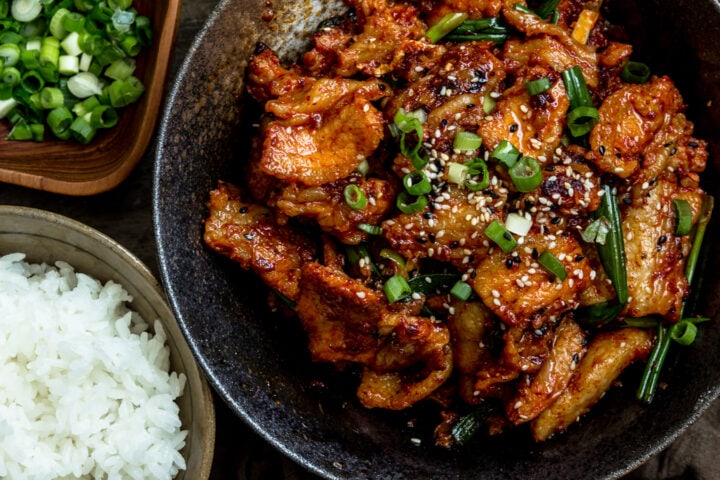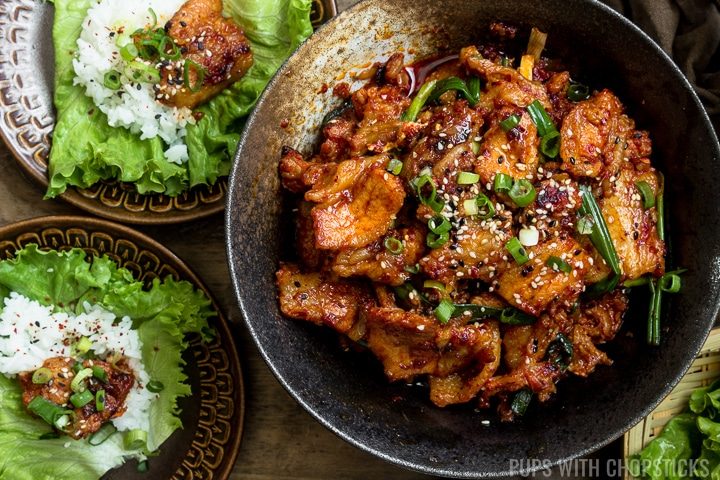Spicy Korean Pork Bulgogi
An easy Spicy Korean Pork Bulgogi recipe made with thin slices of pork belly and a sweet gochujang sauce that can be served with a side of rice, wrapped in a lettuce or used in tacos!
Servings: 4 Servings
Calories: 1026kcal
Ingredients
- 1 ½ lb 650g pork belly (or pork shoulder/pork butt)
- 3 stalks green onions (cut into 1 ½ inch chunks, including the whites)
Marinade
- 2 tablespoons garlic (grated, approximately 5-6 cloves)
- 1 ½ tablespoon ginger (grated, approximately 1 inch of ginger)
- 1 medium onion
- 3 ½ tablespoons gochujang (Korean hot pepper paste)
- 1 tablespoons soy sauce (or ½ tablespoons fish sauce)
- 2 tablespoons honey (or sugar)
- 1 tablespoon sesame oil
- 2 tablespoons mirin cooking wine
- 3 tablespoons water
- 1 tablespoon gochugaru (Korean red chili pepper flakes) (Optional, if you like it spicy)
Instructions
Preparation
- Remove the root end of the green onion and cut them into 1 ½ inch long chunks (including the whites of the green onions). Slice the thicker, white ends lengthwise again so that it is the same thickness as the greens.

- If your pork belly comes with skin, remove the skin and discard it.
- Freeze the pork belly for 1 hour. This will make it easier to slice thinly. If you are using a larger cut of meat like a pork shoulder, you may need to freeze it for a longer period of time.
Marinate the Pork Belly
- Peel the garlic, slice the ginger, and dice the onion into 1-inch cubes.
- In a food processor, blend the garlic, ginger, and onion together into a paste. (You can also grate it by hand if you don't have a food processor.) Place the blended garlic, ginger, and onion in a large bowl.
- Add 3 ½ tablespoons gochujang (Korean hot pepper paste), 1 tablespoons soy sauce (or fish sauce), 2 tablespoons honey, 1 tablespoon sesame oil, 2 tablespoons mirin cooking wine, 3 tablespoons water, and 1 tablespoon gochugaru (Korean red chili pepper flakes) into the bowl with the blended garlic, ginger, and onion and mix everything together.
- Remove the pork belly from the freezer and thinly slice it. I like to slice it approximately ⅛ inch or thinner.
- Add the pork belly into the marinade and mix everything well. Marinade it in the fridge for a minimum of 1 hour (the longer you marinade it, the more flavorful it will be).

Cooking the Spicy Korean Pork Bulgogi
- Set the stove on high heat and set a non-stick frying pan or a high walled pot (to prevent splatter) on the stove and add a bit of oil into it.
- Once the oil is hot, add the pork belly in the pan (including any extra marinade, this will be the sauce)
- Pan fry on high heat for 8-11 minutes. Pork belly splatters quite a bit, so be careful or wear an apron to prevent staining on your clothes.
- Once the pork belly is cooked, turn off heat, add green onions and mix the onions around to let the heat wilt it.
3 Different Ways to Serve This
- The quickest way to enjoy this is to serve it with white rice.

- You can also share this and have it as lettuce wraps! Set out a pile of green leaf lettuce (or perilla leaves), with steamed white rice. To eat it, you can add a bit of rice, green onions, and a piece of Spicy Korean Pork Bulgogi to the lettuce, wrap it, and eat it!

- This spicy Korean pork also goes well in tacos! If you're having a taco night, use this as the protein instead and top it with your usual taco toppings! (I like to add lime juice-pickled red onions, sour cream, and a bit of cheese)
Notes
- I like to use pork belly for this recipe, but this recipe also works with pork shoulder or pork butt as well.
- If you can't find gochugaru (Korean Chili Flakes), you substitute it with cayenne pepper but in half the amount. You can also omit or use half the amount if you don't want your spicy Korean pork bulgogi to be too spicy.
- Mirin is slightly different than Chinese cooking wine because it is sweet in flavor so it cannot be substituted with Chinese cooking wine. If you cannot find Mirin at your Asian grocery store, you can substitute it by mixing either dry sherry or sake with 1 teaspoon of sugar.
Nutrition
Serving: 3/4 cup | Calories: 1026kcal | Carbohydrates: 21g | Protein: 18g | Fat: 96g | Sodium: 477mg | Fiber: 2g | Sugar: 15g
